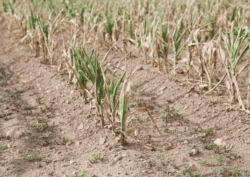In recent decades, agriculture has undergone a transformation towards more sustainable methods, seeking alternatives that promote productivity without depleting natural resources or encouraging overexploitation and contamination. In this context, agricultural biostimulants, particularly organic ones, have emerged as a key tool to enhance crop efficiency, increase their resistance to stress factors, and improve soil quality.

What Are Organic Biostimulants?
Biostimulants are substances or microorganisms applied to plants to optimize growth and development, working together with the nutrients applied to the crop. Unlike fertilizers, which are designed to specifically nourish according to the plant’s needs at each phenological stage, biostimulants directly impact the physiological and metabolic development of the plant. They stimulate strong, uniform growth as well as resistance to biotic and abiotic factors that could affect the crop.
By activating metabolic pathways within the plant, organic biostimulants can induce positive responses to stress conditions, such as drought, salinity, extreme temperatures, or pests. This makes them crucial allies for improving the resilience and productivity of crops, especially in sustainable agricultural systems. As organic alternatives, these biostimulants provide farmers with a natural solution that reduces reliance on synthetic chemicals and enhances environmental stewardship.

Types of Organic Biostimulants
Seaweed Extracts
These extracts contain a wide range of bioactive compounds, including polysaccharides, phytohormones (such as auxins, cytokinins, and gibberellins), and minerals. Additionally, these extracts have the ability to improve soil structure, increase water retention, and prevent damage to plants affected by water stress. Seaweed extract is a biostimulant that influences most physiological processes, improving plant development from the roots to fruit formation.
Amino Acid Compounds
Amino acids, the building blocks of proteins, are essential for plant growth. Biostimulants based on amino acids help plants synthesize proteins more efficiently, resulting in better photosynthesis, increased resistance to damage from biotic and abiotic factors, and enhanced flowering and fruit filling. Additionally, amino acids can stimulate root activity and facilitate nutrient absorption.

Humic and Fulvic Acids
These natural organic compounds, derived from the decomposition of organic matter, positively impact soil structure and biological activity. Humic and fulvic acids stimulate nutrient translocation and act as chelators in poorly soluble mineral compounds. They also improve nutrient availability in the soil, promote root growth, and increase the plant’s ability to withstand stress conditions, such as drought or salinity.
Beneficial Microorganisms
Microbial biostimulants include bacteria and fungi that promote plant growth. Mycorrhizae are fungi that form a symbiotic relationship with the soil and the plant, making mineral elements and water retention available for the crop. Beneficial microorganisms can improve nutrient absorption, stimulate phytohormone production, and help plants defend against pathogens.
Benefits of Organic Biostimulants
The application of organic biostimulants to crops offers multiple benefits for the plants, the soil, and the environment. Organic alternatives like these can be formulated or directly applied in the field to enhance soil fertility and stimulate plant development, ultimately increasing the quantity and quality of harvests.

Here are some key benefits of applying organic biostimulants:
Improves Nutrient Absorption
Biostimulants not only complement and enhance existing elements in the soil for the plant, but when combined with standard fertilization, they also increase the efficiency of each element. This creates appropriate physiological nutrition through nutrient transport, maximizing water and mineral absorption for higher-quality development.
Stimulates Plant Growth
Specific qualities of using organic biostimulants include promoting root development: strong, abundant roots that are particularly resistant to water stress, soil pests, and root diseases. They accelerate seed germination, stimulate uniform plant growth, and enhance processes such as flowering and fruit formation.

Resistance to Biotic and Abiotic Factors
Climatic variability directly impacts agriculture, with abiotic factors such as drought, frost, high temperatures, and poor soils, as well as biotic factors like increasingly resistant pests and diseases. Strengthening crops with organic products improves their immune system, increasing their resistance to these challenges.
Improves Crop Quality and Yield
The use of organic products boosts agricultural production, resulting in crops with better quality, including improved size, texture, taste, and weight. Organic products promote better yields, higher-quality fruits, lower environmental impact, and even reduced production costs.
Sustainability and Environmental Care
The growing demand for food has led to faster production methods, resulting in excessive use of fertilizers and agrochemicals, which harm natural resources. Organic products promote a sustainable relationship between the soil, plants, and the ecosystem, reducing pollution. Additionally, biostimulants contribute to biodiversity and ecological balance.

In conclusion, organic agricultural biostimulants provide an effective and sustainable alternative to enhance crop productivity, increase resistance to stress, and improve soil quality. These products not only boost nutrient efficiency but also contribute to the overall health of plants and the ecological balance of agricultural ecosystems. By incorporating biostimulants into farming practices, farmers not only optimize their harvests but also promote a more responsible and environmentally friendly form of agriculture. The adoption of these products is not just a trend but a necessity to move towards a more sustainable agricultural future that protects both natural resources and the quality of the food we produce.

